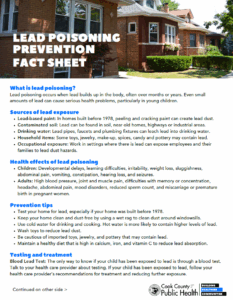
Lead Poisoning Overview
What is lead poisoning?
Lead poisoning is the number one environmental illness of children.
Lead is a poisonous metal that our bodies cannot use. Lead poisoning is hard to see, but it is very harmful. There is no safe level of lead in the blood.
Lead can cause:
- Lowered IQ and learning problems.
- Trouble concentrating and paying attention
- Speech disorders
- Anemia (a disease caused by low iron levels), which can result in tiredness, shortness of breath, and difficulty paying attention.
- When exposed children become adults, they have a higher risk of high blood pressure and heart disease.
Common Sources of Lead
Housing built before 1978
Lead was used in paint before it was banned in the United States in 1978. Deteriorating lead-based paint, lead dust from renovation or deterioration in older buildings and contaminated soil remain the most likely sources of childhood lead exposure. Most lead poisonings in children result from children eating paint chips or through breathing lead dust. They can also get dust and paint chips on their hands and then put their hands in their mouths.
- Learn when your home was built.
- Find information on home inspections.
- See if you qualify for grant funding to assess and remove lead hazards.
From mother to fetus
Lead in the blood can cross the placenta and affect an unborn child. Even lead stored in bones can be mobilized and expose the woman and fetus. Lead poisoning of the fetus can cause low birth weight, stillbirth or miscarriage. To protect your baby, get enough calcium, and eat a well-balanced diet. Talk to your physician about getting tested for lead during your pregnancy, especially if you live in a home built before 1978, or if you’ve craved any non-food items.
Other sources
Lead can also be found in these other sources:
- Soil – Lead particles that settle on the soil from gasoline or paint.
- Water – Lead pipes, brass plumbing fixtures and copper pipes lined with lead can release lead particles into tap water.
- Cosmetics – Some cosmetics such as Kohl, kajal and surma can contain high levels of lead.
- Imported pottery – some pottery, especially pottery and bean bowls made in Mexico, have lead in the glaze.
- Candy – some imported candies have lead. Check this ‘toxic treats’ list to see the candies from Mexico that have been found to be contaminated with lead. (ENGLISH | SPANISH )
- Occupation – Parents who work in construction or renovation jobs, or work at gun ranges, can expose their children to lead dust. Parents can bring lead dust home on work clothes, shoes and the family car.
- Hobbies – Some hobbies that may involve activities, such as lead soldering may expose children to lead

Updated December 2, 2025, 12:35 PM
